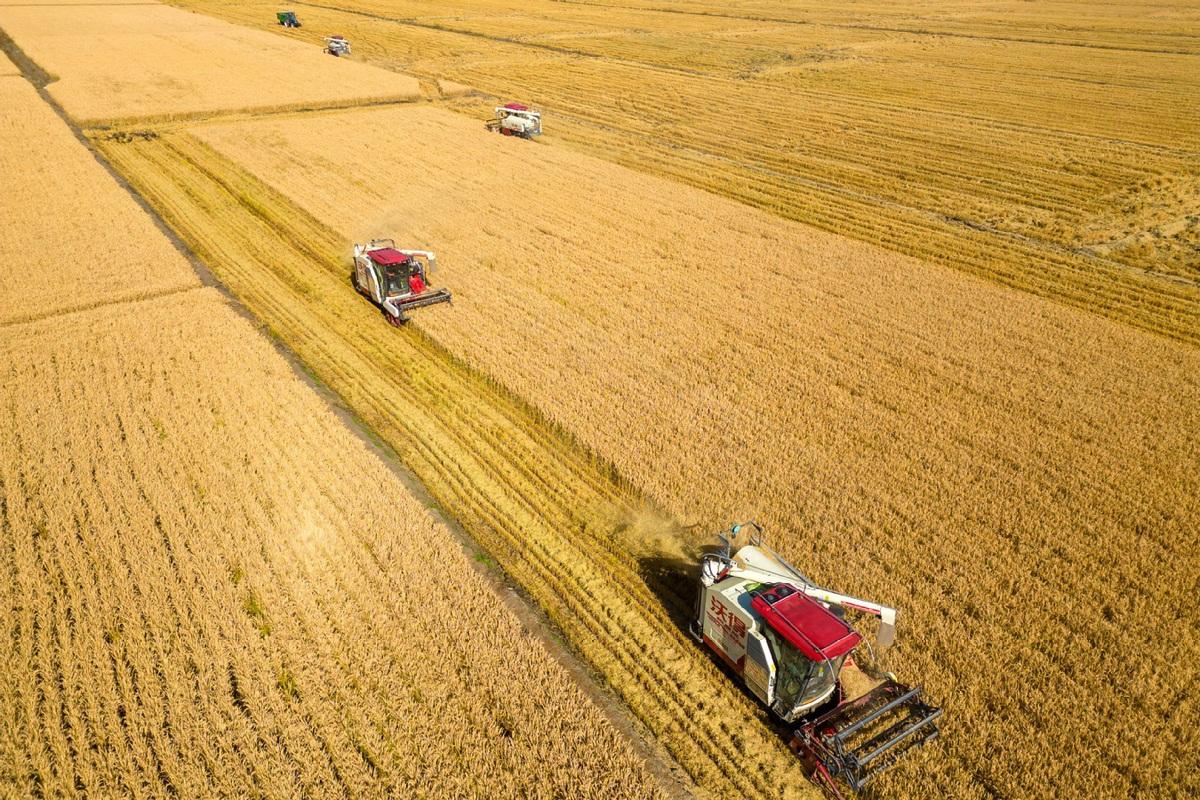China Daily | October 28, 2024

An aerial drone photo shows agricultural machines working in fields at a farm of Beidahuang Group in Northeast China's Heilongjiang province, Oct 12, 2024. [Photo/Xinhua]
Despite major food-producing areas being buffeted by typhoons and other extreme weather conditions earlier this year, agricultural officials said the nation's grain yield is expected to hit a record high.
While expressing optimism about national food security, they cautioned over a "tight balance" in food supply due to structural challenges such as inadequate self-sufficiency in corn and soybeans.
China is on track to surpass 700 million metric tons in grain yield for the first time after maintaining the figure above 650 million tons for nine consecutive years, Vice-Minister of Agriculture and Rural Affairs Zhang Xingwang said on Friday.
During a news conference organized by the State Council Information Office in Beijing, Zhang said the summer grain output has experienced the most significant year-on-year increase in nine years. Production rose by 3.625 million tons compared to the previous year, reaching a total of 149.78 million tons.
"We'll have yet another bumper harvest year," he said.
Officials reported that the output of early rice, cultivated in early spring and harvested in summer in southern provinces, was 28.175 million tons this year, down 0.6 percent due to reduced productivity caused by unfavorable weather conditions.
Despite the lackluster performance of early rice, the growing areas for food crops that ripen in autumn and contribute to more than 70 percent of China's annual food output have expanded this year, leading to improved productivity across the board, Zhang said.
As of Thursday, 82.5 percent of the autumn crops had been harvested, indicating a successful growing season thus far.
Zhang described this year's food production as relatively smooth.
Super typhoons in South China, heavy downpours in the middle and lower reaches of the Yangtze River, sudden shifts between droughts and floods in the Huang-Huai-Hai region that encompasses parts of the Yellow River, Huaihe River and Haihe River basins, as well as periodic low temperatures and extreme heavy rains in the northeast, have all wreaked havoc on local agricultural production.
"However, from a national perspective, this year's agricultural disasters are less severe compared to recent years," the vice-minister said, adding that the affected area of crops this year is 2.93 million hectares smaller than a normal year.
Zhang pointed to a structural deficiency in corn and soybeans — key raw materials for making animal feed and cooking oil — despite recent initiatives to enhance their planting areas and productivity through the introduction of higher-yield varieties.
He said that the soybean cultivation area, a crop heavily reliant on imports, was about 10 million hectares this year, yielding around 20 million tons.
"The national balance between grain supply and demand remains tight, with no significant changes observed. We must remain vigilant at all times to ensure a stable and secure supply of grains," Zhang added.
The structural imbalance was also noted in the China and Global Food Policy Report 2024, published earlier this month.
The report pointed to a decline in consumer demand for grains and cereals in China and a rising interest in protein-rich and nutrient-dense foods, a change that underscores the need to revamp the country's agrifood system, which heavily relies on arable land.
Authorities have increasingly advocated for the concept of macro foods in hopes of capitalizing on the food-yielding potential of forests, grasslands, rivers and lakes, as China investigates novel protein and carbohydrate sources beyond traditional crops.



